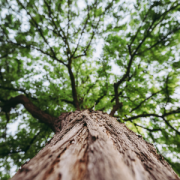The event began with a hole. Beside it was the tree that would soon call it home, the ball of roots still wrapped in burlap, waiting to be planted in the earth on a median near a church in Detroit, Michigan, USA. But with a podium nearby and a crowd gathered to see the urban forestry experts do their work, this tree wasn’t your average landscaping project. Instead, it was among the first of tens of thousands to be planted across targeted areas of the city as part of the Detroit Tree Equity Partnership (DTEP).
This initiative, formally launched with a press conference on 11 October 2022, is a US $30 million investment in Detroit to increase the city’s tree canopy and all the benefits that come with that. Led by American Forests, DTE Energy, Detroit Future City, the Greening of Detroit, and the City of Detroit, DTEP will plant 75,000 trees in highlighted areas across the city over five years while hiring 300 Detroiters and training them in the craft of tree planting and maintenance.
It Takes a Village
Although numerous organizations and businesses have been working to add to Detroit’s tree canopy and improve quality of life for its residents for years, the ambitious nature of the DTEP project is only feasible because of its partners.
“When we first engaged with American Forests about this, we asked what it would take to build an amazing tree equity program,” says Shawn Patterson, DTE Energy VP of environmental management and safety. “We were very careful around aligning everyone and their interests around this partnership. There were a lot of one-on-one conversations. We didn’t want to launch something that sounded flashy; we wanted to build something with these stakeholders.”
The partnership is indeed working toward something meaningful. The benefits of adding trees to a community go far beyond the superficial. Adding 75,000 trees to the city will sequester 152,000 pounds of carbon over 40 years, reduce stormwater runoff by 303 million gallons over the same time frame, and save residents US $12 million in energy costs, according to the Tree Equity Score (TES) by American Forests.
Adding as many trees as DTEP intends will also help mitigate climate change impacts and improve public health outcomes. Per TES, street trees decrease temperature within 30 meters (about 34 yards) by .4 to 4 degrees Celsius (32.7-39.2 degrees Fahrenheit), a big impact since an increase of 1 degree Celsius (33.8 degrees Fahrenheit) can increase all-cause mortality rates by 3% to 5.5%. For every additional 340 trees per square mile, the rate of childhood asthma decreases by 25%. This can greatly benefit area residents: Detroit’s childhood asthma rate is 74% higher than the rest of Michigan. There are economic benefits, too. Street trees add nearly 1% to property values, and the jobs portion of the project will add $23 million in earnings to Detroit households.
The Greening of Detroit is more than familiar with all the benefits trees offer to an urban landscape. Bringing those benefits home to Detroit has long been a core part of the work they do, and becoming an integral part of DTEP was a natural fit.
“Improving the quality of life for Detroiters has been our mission,” says Monica Tabares, VP of operations and development for the Greening of Detroit. “That’s why the organization was formed, to meet those environmental needs and the community needs. The priority being increasing the city’s tree equity and providing that green space, a tree canopy that a city of this size and its residents deserve.”
Access to trees and the benefits that come from them in urban areas is becoming increasingly important. By 2030, nearly 80% of the population of the US will live in cities or suburbs, according to TES, making those benefits harder to come by in daily life.
Although this will be a challenge on a national scale, American Forests was eager to show how it could be tackled through work with DTEP.
“Detroit’s reputation and history of ingenuity in everything from manufacturing to music makes it a great place to show how improving tree equity can contribute to a city’s vitality in the 21st century,” says Eric Candela, American Forests’ director of local government relations. “American Forests is trying to do three innovative things simultaneously that we hope will contribute to our success in Detroit and have broad appeal beyond. We are leading with tree equity, trying to improve canopy in the areas of the city where trees can do the most good.
“Secondarily, by making room for more stakeholders (like DTE Energy) to participate in the work, we have effectively increased the management capacity that Detroit is able to apply to urban forestry. Finally, by treating trees as assets and monetizing the benefits they provide, we are increasing the funding available to support this work. American Forests is confident that cities throughout the country will want to replicate this approach.”
[For more from the author on this topic, see: “From Blight to Beauty: A Way Forward for Urban Forestry.”]



